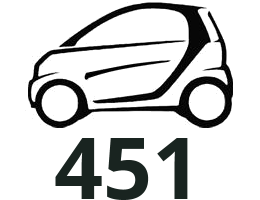Mod Details
PremiumNo Difficulty



 Mod ID1322
Creditevilution
For
Mod ID1322
Creditevilution
For Linkhttps://www.evilution.co.uk/mod/451-ed-12v-power-usage.htm Copy to Clipboard
Linkhttps://www.evilution.co.uk/mod/451-ed-12v-power-usage.htm Copy to ClipboardThe Smart 451 ED has 2 batteries, well, it acually has 94 batteries but 93 of them make up the 400v drive battery.
It also has the standard 12v lead acid battery that you’d normally get in a petrol and diesel smart. It’s this battery that runs all of the electronics and electrics on the car. As the ED doesen’t have an alternator, voltage must be taken from the 400v drive battery to charge the 12v battery.
The 12v battery is fed with 14.8 volts from the 400v battery when the car is turned on. Depending on the amperage draw on the 12v battery, more amperage is taken from the 400v battery. So, the less power you use from the 12v battery, the more you have for driving, so you can go further.
Volts, Amps And Watts
For those who don’t understand electricity, there’s easily understood simile.
Imagine a river.
Voltage is the depth of the river.
Amperage is the speed of the river.
Wattage is the combination of volts and amps.
So, wattage is like a water wheel in the river.
The charge voltage is a constant 14.8v
So, the only variable is amperage which then affects the wattage.
Volts x Amps = Watts
Electrical items will take whatever voltage is given to them but they will only take the amperage it needs.
Amperage Use @ 14.8v
| Electrical Item | Power Usage In Amps | Power Usage In Watts |
| Car turned off | 0.3 – 1.0 | 4.44 – 14.8 |
| Car turned on | 5.4 | 79.9 |
| Stereo | 1.8 | 26.6 |
| Heated seat stage 1 | 0.9 | 13.3 |
| Heated seat stage 2 | 6.4 | 94.7 |
| Both heated seats on stage 2 | 12.7 | 187.9 |
| Cabin fan stage 1 | 3.8 | 56.2 |
| Cabin fan stage 2 | 6.7 | 99.1 |
| Cabin fan stage 3 | 10.4 | 153.9 |
| Cabin fan stage 4 | 16 | 236.8 |
| Rear screen heater | 16.8 | 248.6 |
| Window motors | 6.6 (each) | 97.6 (each) |
| H7 low beam headlights | 9.4 (pair) | 139.1 (pair) |
| H7 high beam headlights | 9.4 (pair) | 139.1 (pair) |
| Rear marker lights | 0.9 (pair) | 13.3 (pair) |
| Brake lights x3 | 5.1 (for 3) | 75.4 (for 3) |
| Number plate lights | 1.58 (pair) | 23.3 |
| Interior courtesy light | 0.8 | 11.8 |
| Reverse light | 2 | 29.6 |
| Rear fog light | 2 | 29.6 |
| Indicator front | 3.92 (pair) | 58 |
| Indicator rear | 3.92 (pair) | 58 |
| Indicator side | 0.8 (pair) | 11.8 |
| Front marker lamps | 0.8 (pair) | 11.8 |
| Day time running lights | 1.7 (pair) | 25.1 |
That’s A Lot Of Numbers
Agreed but it shows you how much power has to be removed from the drive battery to top up the 12v battery. The less you use, the less is taken from the drive battery. Just driving at night, you are using an extra 180 watts of power (ish).
That’s three 60 watt old style light bulbs you normally use in a house. That’s a lot of power.
Increasing Efficiency Or Just Use Less Power
Using the heater will knock up to 10% off of your drive battery range (shown on the speedo). So, not using the heater, rear screen heater, heated seats, high beam headlights etc will save power. However, for things that you can’t ignore, like headlights during the night, you can use more efficient lights.
Many of the lights can be replaced with LEDs. Do NOT use cheap LEDs. Look for quality lights from Osram or Ring. Do not buy products that aren’t in their packaging. There are a lot of shitty copies of good LED lights. I bought these.

Light Alternatives
(Listed) is the wattage written on the package. This is at 12 volts.
(Actual) is the wattage when run at 14.8 volts.
The ratings are for each bulb of that type.
| Bulb | Halogen bulb wattage | Xenon bulb wattage | LED bulb wattage |
| H7 low beam | 55 (listed) – 69 (actual) | 35 (listed) – 47 (actual) | 11.2 |
| H7 high beam | 55 (listed) – 69 (actual) | 35 (listed) – 47 (actual) | 11.2 |
| Rear marker light | 5 (listed) – 6.6 (actual) | 0.4 | |
| Brake light | 21 (listed) – 28.8 (actual) | 1.3 | |
| Number plate light | 5 (listed) – 5.7 (actual) | 3.1 | |
| Courtesy light | 5 (listed) – 5.7 (actual) | 3.1 | |
| Reverse light | 21 (listed) – 28.8 (actual) | 1.3 | |
| Rear fog light | 21 (listed) – 28.8 (actual) | 1.3 | |
| Indicator front | 21 (listed) – 28.8 (actual) | 1.3 | |
| Indicator rear | 21 (listed) – 28.8 (actual) | 1.3 | |
| Front marker light | 5 (listed) – 5.7 (actual) | 1.2 |
The main thing that can be taken from this table is that LEDs are far more efficient. However, LED H7 bulbs are currently shit and should not be used. They just aren’t bright enough.
The number plate and interior courtesy light have a higher wattage usage than the much more powerful LED lights, mainly because they are less efficient.
HIDs (xenon) lights are about a third more efficient than halogen lights. However, they produce 2 – 3 times more light but not road legal.
Better Licence Plate Lights
Obviously, 5.7 watts of power isn’t much when it comes to a lamp but the LED replacements I used from RING weren’t that much better with a rating of 3.1 watts. We can do better if we tried. On the right is the standard lamp. In the centre is the LED replacement by RING. It’s bright and white. On the left is a full replacement with potted LEDs. This unit replaces the entire light housing. It actually uses 1.9 watts of power per unit. It’s lower and lower is better.

That’s all I can think of regarding lights.
Don’t Use The Heater
What if I’m freezing cold?
Wear more clothes. Wear gloves, a hat and thick socks. Use the heated seats before considering using the heater. If you really have to, use the heater for only a short duration.
The electric PTC heater for the cabin will heat up really quickly so it doesn’t take long to bring the temperature up. Once the cabin is warm, turn it off to save power.
If the car is plugged in and charging, you can preheat the cabin.
The Windscreen Is Fogging Up
Open both side windows very slightly. Use the heater on the windscreen for a short duration. Don’t use the AC unless it’s an absolute emergency. If the car is plugged in and charging, you can preheat the cabin to clear the screen.
Running a mains powered dehumidifier in the car regularly in the winter will help.
12v Battery Goes Flat Quickly
I have a Ctek charge indicator panel on my ED 12v battery. It flashes either red, amber or green depending on the voltage of the battery. I have the same indicator panel on my petrol 451. On the petrol model, the amber light would take a day to start flashing and another 2 days to start flashing red. On the electric model, amber would appear in an hour and red would appear 2 hours or so after that.
Like the standard engine version, the 12v battery in the ED will only charge when the car is running. The ED charges the battery at 14.8 volts instead of 14.4 volts in the petrol/diesel model.
The difference is the resting amperage of both types of car.
The petrol/diesel model has a resting amperage of about 0.15 amps.
The electric model has a resting amperage of between 0.3 and 1 amp.
It looks like the ED runs occasional electrical tests throughout the day.
Smart released an update to the car which booted the car up regularly throughout the day in order to keep the 12v battery charged. The problem with that is it drains the drive battery to do so.
Credits
Thanks to Fran T for the info about the battery drain and software update.


